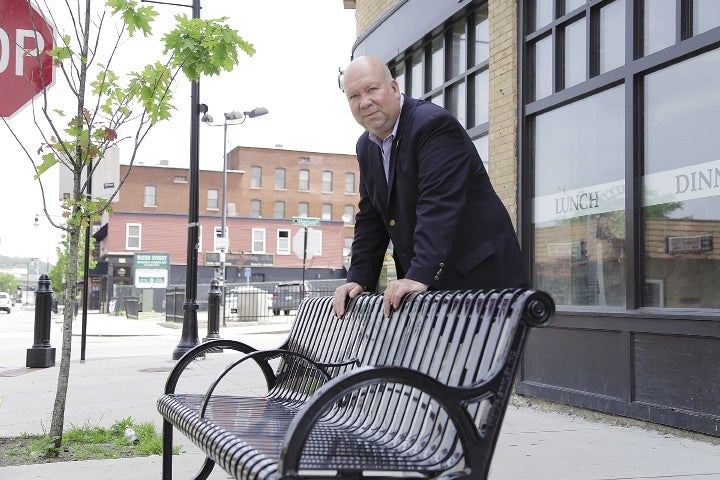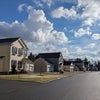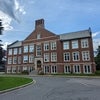Officials work to make downtown Worcester more walker-friendly
Bringing in tenants was a tough task for Dino Lorusso after he bought a 50,000-square-foot former industrial building in Worcester's Canal District in 2007.
Visitors to Crompton Place in the late 2000s often entered with a poor taste in their mouths due to Green Street's paucity of trees and numerous vacant buildings with boarded-up windows.
“Pedestrians and traffic were non-existent down here,” Lorusso said.
He started to confront the problem by installing lights on his Harrison Street buildings so walkers and bikers would feel more comfortable moving between Green and Water streets after dark.
Then Worcester picked up the baton, thanks to $7.6 million in federal stimulus money it received in 2010.
Over the past three years, the city has added bike lanes, curb extensions, greenery and lighting along Water, Millbury and Green streets, said Stephen Rolle, the city's director of planning and regulatory services. Crosswalks and sidewalks in those areas were also improved through the use of red, textured pavement that looks like brick.
The upgrades made a difference.
“Once the streetscape came in, the first thing people started looking at was the trees,” Lorusso said. “It softened the street.”
The greenery diverted attention from the nearby abandoned buildings, Lorusso said, though those too have largely gone by the wayside as pedestrian activity increases in the area.
And with rental inquiries on the rise at Lorusso's 138 Green St. building. He plans to convert the top two floors into apartments in roughly a year.
The streetscape improvements also helped facilitate the expansion of restaurants, bars and other retail establishments onto Millbury Street, said John Giangregorio, president of the Canal District Alliance and owner of Three G's Sportsbar on Millbury Street. Prior to the improvements, cracked sidewalks and spotty streetlights kept many tenants and patrons away.
“The neighborhood was not very attractive,” Giangregorio said.
Walk this way, but maybe not that way
Walkability along Worcester's commercial corridors is a mixed bag, with some areas benefitting from recent upgrades while others languish from decades of neglect or a car-oriented approach.
“The day of the automobile-centric city has gone,” said Jerry Powers, co-coordinator of WalkBike Worcester. “Cities that want to be vibrant and attractive in the future must appeal to pedestrians.”
As in the Canal District, boosting the streetscape was a precursor to Shrewsbury Street's revitalization.
The area was Worcester's first to receive walkability improvements, which Rolle said took place from 2003 to 2005 and were similar to the work done later in the Canal District.
With more pleasant sidewalks and a safer street-crossing experience, Shrewsbury Street is now booming with more than 40 restaurants.
“Good walking is good traffic,” said Karin Valentine Goins, co-coordinator of WalkBike Worcester. “When you increase foot traffic, you increase sales.”
Officials hope that success will spill into downtown after the reopening of Front Street between Foster and Church streets at the end of 2012.
Prior to the work, visitors coming into Union Station had to find their way around the old Galleria Mall parking garage and over to Franklin Street to reach downtown, said Jonathan Church, project manager with the Central Massachusetts Regional Planning Commission.
Knocking down the garage and reconnecting the grid was the best thing the city could have done to boost pedestrian access, since newcomers could now see a direct route between the train station and downtown, said Church, who noted the new connection has become well used.
But downtown walkability remains a work in progress.
“Very few people like walking downtown,” said Powers, who cited the abundance of surface parking lots as a pedestrian problem. “I do it, but it's not pleasant.”
To address this issue, streetscape and sidewalk improvements similar to those on Shrewsbury Street and in the Canal District are underway on the roads surrounding Worcester Common and City Hall, Rolle said.
The more extensive work, though, is slated for Main Street between Highland and Chandler streets, and will include roadway repaving, traffic signal improvements and pedestrian upgrades, Rolle said.
U.S. Rep Jim McGovern, D-Worcester, secured some $4.5 million in federal money for the project, and Rolle said reconstruction is slated to begin in approximately 2016.
But how far the project will go is still up for debate.
WalkBike Worcester is pushing hard to narrow Main Street from two lanes to one in each direction, Powers said. Its proposal would make room for a center-turn lane or a green median strip in the road, as well as bike lanes in each direction and more on-street parking.
Narrowing Main Street would slow automobile traffic, making it easier for pedestrians to cross the street, Goins said. That, in turn, would help draw businesses downtown that rely on foot traffic, she said.
Powers noted that, outside of rush hour, virtually no drivers abide by Main Street's posted speed limit of 30 miles per hour.
“When you have two lanes in one direction, you get this racetrack mentality,” he said.
However, both Powers and Goins said the city is planning to keep four lanes for automobile traffic. Rolle said the project is still early in the design process and that the public will have a chance to weigh in at a hearing later this year.
The most ambitious pedestrian project, though, could occur in the Canal District.
Giangregorio, of the Canal District Alliance, said many in the area would be interested in reopening the Blackstone Canal running under Harding Street between Union Station and Kelley Square as part of a larger effort to create a new national historic park between Worcester and Providence.
The Massachusetts House of Representatives has approved $3 million for a feasibility study to determine the time and cost associated with reopening part of the canal, Giangregorio said. Harding Street was built in 1890 to cover up the historic waterway, which thrived during the Industrial Revolution in the mid-1800s and sits 12 feet below street level.
Giangregorio envisions the reopened canal being a huge walking attraction. He thinks the loss of a portion of Harding Street would pose only a minimal inconvenience to cars.
“It's encouraging,” Lorusso said. “It's a good feeling for Worcester.”











0 Comments